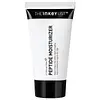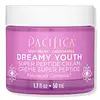What's inside
What's inside
 Key Ingredients
Key Ingredients

 Benefits
Benefits

 Concerns
Concerns

 Ingredients Side-by-side
Ingredients Side-by-side

Water
Skin ConditioningCaprylic/Capric Triglyceride
MaskingGlycerin
HumectantC12-15 Alkyl Benzoate
AntimicrobialCetearyl Alcohol
EmollientGlyceryl Stearate Se
EmulsifyingBetaine
HumectantButylene Glycol
HumectantPhenoxyethanol
PreservativeBenzyl Alcohol
PerfumingCarbomer
Emulsion StabilisingButyrospermum Parkii Butter
Skin ConditioningSodium Stearoyl Glutamate
CleansingSodium Hydroxide
BufferingEthylhexylglycerin
Skin ConditioningSodium Gluconate
Skin ConditioningTocopheryl Acetate
AntioxidantDehydroacetic Acid
PreservativeHydrogenated Lecithin
EmulsifyingPhenethyl Alcohol
MaskingAcetyl Hexapeptide-37
Skin ConditioningMaltodextrin
AbsorbentPentapeptide-48
Skin ConditioningWater, Caprylic/Capric Triglyceride, Glycerin, C12-15 Alkyl Benzoate, Cetearyl Alcohol, Glyceryl Stearate Se, Betaine, Butylene Glycol, Phenoxyethanol, Benzyl Alcohol, Carbomer, Butyrospermum Parkii Butter, Sodium Stearoyl Glutamate, Sodium Hydroxide, Ethylhexylglycerin, Sodium Gluconate, Tocopheryl Acetate, Dehydroacetic Acid, Hydrogenated Lecithin, Phenethyl Alcohol, Acetyl Hexapeptide-37, Maltodextrin, Pentapeptide-48
Water
Skin ConditioningHelianthus Annuus Seed Oil
EmollientMyristyl Myristate
EmollientIsopropyl Myristate
EmollientC12-15 Alkyl Benzoate
AntimicrobialButyrospermum Parkii Butter
Skin ConditioningStearic Acid
CleansingGlyceryl Stearate Citrate
EmollientGlycerin
HumectantPalmitoyl Tripeptide-5
Skin ConditioningDipeptide Diaminobutyroyl Benzylamide Diacetate
Skin ConditioningPropanediol
SolventGlyceryl Stearate
EmollientSodium Stearoyl Glutamate
CleansingCetyl Alcohol
EmollientStearyl Alcohol
EmollientBetaine
HumectantArginine
MaskingSodium PCA
HumectantHibiscus Sabdariffa Flower Extract
Skin ConditioningIris Pallida Leaf Cell Extract
AntioxidantRosa Damascena Flower Water
MaskingPelargonium Graveolens Oil
MaskingDibutyl Lauroyl Glutamide
Skin ConditioningTocopheryl Acetate
AntioxidantXanthan Gum
EmulsifyingPhenoxyethanol
PreservativeEthylhexylglycerin
Skin ConditioningWater, Helianthus Annuus Seed Oil, Myristyl Myristate, Isopropyl Myristate, C12-15 Alkyl Benzoate, Butyrospermum Parkii Butter, Stearic Acid, Glyceryl Stearate Citrate, Glycerin, Palmitoyl Tripeptide-5, Dipeptide Diaminobutyroyl Benzylamide Diacetate, Propanediol, Glyceryl Stearate, Sodium Stearoyl Glutamate, Cetyl Alcohol, Stearyl Alcohol, Betaine, Arginine, Sodium PCA, Hibiscus Sabdariffa Flower Extract, Iris Pallida Leaf Cell Extract, Rosa Damascena Flower Water, Pelargonium Graveolens Oil, Dibutyl Lauroyl Glutamide, Tocopheryl Acetate, Xanthan Gum, Phenoxyethanol, Ethylhexylglycerin
 Reviews
Reviews

Ingredients Explained
These ingredients are found in both products.
Ingredients higher up in an ingredient list are typically present in a larger amount.
Betaine is a common humectant (a substance that promotes retention of moisture). It's known to be gentle on the skin and can help balance hydration.
This ingredient is best for improving hydration and soothing irritated skin. Studies also show it helps even out skin tone.
Fun fact: Betaine is naturally created in the skin and body. The kind found within cosmetic products can be either plant-derived or synthetic.
Another name for betaine is trimethylglycine.
Learn more about BetaineThis ingredient is also known as shea butter. It is an effective skin hydrator and emollient.
Emollients help soothe and soften your skin. It does this by creating a protective film on your skin. This barrier helps trap moisture and keeps your skin hydrated. Emollients may be effective at treating dry or itchy skin.
Shea butter is rich in antioxidants. Antioxidants help fight free-radicals, or molecules that may harm the body. It is also full of fatty acids including stearic acid and linoleic acid. These acids help replenish the skin and keep skin moisturized.
While Shea Butter has an SPF rating of about 3-4, it is not a sunscreen replacement.
Shea butter may not be fungal acne safe. We recommend speaking with a professional if you have any concerns.
Learn more about Butyrospermum Parkii ButterC12-15 Alkyl Benzoate is made up of Benzoic Acid and long chain alcohols. It has a low molecular weight.
C12-15 Alkyl Benzoate is an emollient and texture enhancer. Due to its solubility, it is often used in sunscreens to help evenly distribute active ingredients.
As an emollient, C12-15 Alkyl Benzoate helps soften and hydrate your skin. Emollients create a film on your skin that traps moisture within.
This ingredient has been reported to cause eye irritation.
Learn more about C12-15 Alkyl BenzoateEthylhexylglycerin (we can't pronounce this either) is commonly used as a preservative and skin softener. It is derived from glyceryl.
You might see Ethylhexylglycerin often paired with other preservatives such as phenoxyethanol. Ethylhexylglycerin has been found to increase the effectiveness of these other preservatives.
Glycerin is already naturally found in your skin. It helps moisturize and protect your skin.
A study from 2016 found glycerin to be more effective as a humectant than AHAs and hyaluronic acid.
As a humectant, it helps the skin stay hydrated by pulling moisture to your skin. The low molecular weight of glycerin allows it to pull moisture into the deeper layers of your skin.
Hydrated skin improves your skin barrier; Your skin barrier helps protect against irritants and bacteria.
Glycerin has also been found to have antimicrobial and antiviral properties. Due to these properties, glycerin is often used in wound and burn treatments.
In cosmetics, glycerin is usually derived from plants such as soybean or palm. However, it can also be sourced from animals, such as tallow or animal fat.
This ingredient is organic, colorless, odorless, and non-toxic.
Glycerin is the name for this ingredient in American English. British English uses Glycerol/Glycerine.
Learn more about GlycerinPhenoxyethanol is a preservative that has germicide, antimicrobial, and aromatic properties. Studies show that phenoxyethanol can prevent microbial growth. By itself, it has a scent that is similar to that of a rose.
It's often used in formulations along with Caprylyl Glycol to preserve the shelf life of products.
Sodium Stearoyl Glutamate is an emulsifier and helps condition the skin. It is amino acid-based.
In higher amounts, it may act as a cleansing agent.
Tocopheryl Acetate is AKA Vitamin E. It is an antioxidant and protects your skin from free radicals. Free radicals damage the skin by breaking down collagen.
One study found using Tocopheryl Acetate with Vitamin C decreased the number of sunburned cells.
Tocopheryl Acetate is commonly found in both skincare and dietary supplements.
Learn more about Tocopheryl AcetateWater. It's the most common cosmetic ingredient of all. You'll usually see it at the top of ingredient lists, meaning that it makes up the largest part of the product.
So why is it so popular? Water most often acts as a solvent - this means that it helps dissolve other ingredients into the formulation.
You'll also recognize water as that liquid we all need to stay alive. If you see this, drink a glass of water. Stay hydrated!
Learn more about Water